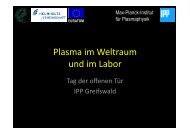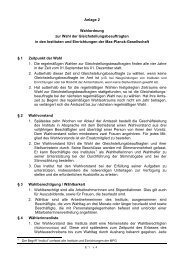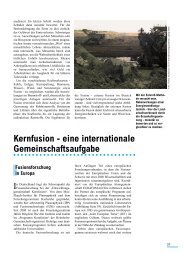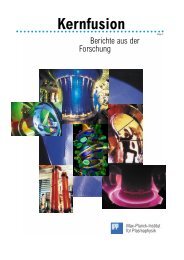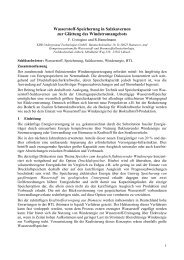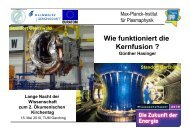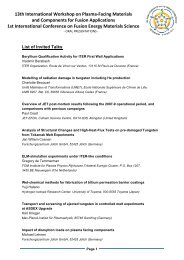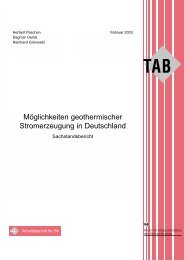IPP Annual Report 2007 - Max-Planck-Institut für Plasmaphysik ...
IPP Annual Report 2007 - Max-Planck-Institut für Plasmaphysik ...
IPP Annual Report 2007 - Max-Planck-Institut für Plasmaphysik ...
You also want an ePaper? Increase the reach of your titles
YUMPU automatically turns print PDFs into web optimized ePapers that Google loves.
WEGA<br />
Head: Dr. Matthias Otte<br />
Laboratory Plasma Devices WEGA and VINETA<br />
Electron Cyclotron Wave Physics<br />
The plasma at WEGA is generated<br />
for low magnetic field operation<br />
of B 0 =60 mT by magnetrons<br />
at a frequency of 2.45 GHz.<br />
The over-dense plasma operation<br />
(>10 times cut-off density for<br />
2.45 GHz) is achieved with mode<br />
conversion Bernstein wave heating.<br />
Raytracing calculations by Preinhalter and Urban, (<strong>IPP</strong><br />
Prague/Czech Republic) confirmed the propagation of the<br />
Bernstein waves in the over-dense plasma region. Although the<br />
WEGA double slot antenna has a symmetric emission profile in<br />
toroidal co- and counter direction, these calculations also showed<br />
a beam propagation in one toroidal direction only, which should<br />
generate Bernstein wave driven toroidal currents. The predicted<br />
current was detected by an external out-of-vessel Rogowski<br />
coil and by the primary coil current at the WEGA transformer.<br />
Power modulation experiments (6 kW on-off at a modulation<br />
frequency of 30 Hz) showed a maximum toroidal current amplitude<br />
of I t =50 A. This current strongly depends on the magnetic<br />
configuration and could even be reversed in case of magnetic<br />
shear reversal. Furthermore, the current density profile inside the<br />
plasma could be measured with small movable Rogowski coils.<br />
This makes WEGA an unique experiment to investigate<br />
Bernstein wave driven currents. The 28 GHz ECRH system was<br />
successfully built and commissioned and is now fully operational<br />
at the second harmonic resonance at 0.5 T. A microwave power<br />
of up to 10 kW is typically used for 15 s plasma operation. The<br />
waveguide system generates an HE11 beam, which is focussed<br />
into the plasma center by an optimized double mirror system inside<br />
the plasma vessel. The resonant character of the absorption<br />
could be verified by on- and off-axis heating experiments.<br />
In argon plasmas a density of n e =4.9×10 18 m -3 and a temperature<br />
of T e =25 eV in the central region could be achieved. Furthermore,<br />
the microwave stray radiation measurement indicates a<br />
strongly enhanced resonant absorption by multiple wall reflections<br />
as predicted by TRAVIS ray-tracing code calculations.<br />
However, in hydrogen discharges an electron temperature<br />
T e >20 eV is achieved already at the plasma edge. For such plasmas<br />
the central region is not longer accessible with simple<br />
Langmuir probes because they start to emit electrons distorting<br />
the characteristics. Therefore, contact-less diagnostics, like Heavy<br />
Ion Beam Probe (HIBP), Electron Cyclotron Emission (ECE),<br />
a bolometer and a reflectometer are being implemented now.<br />
Results from Plasma Experiments<br />
Turbulence studies have been continued in order to identify the<br />
driving instability mechanism and to give a three-dimensional<br />
characterization of the structure of the turbulence. A small<br />
On WEGA experiments were focused on electron<br />
cyclotron wave physics, on fluctuation,<br />
biasing studies and preparations for 0.5 T plasma<br />
operation. Furthermore, the prototype installation<br />
of the W7-X control system made significant<br />
progress. In VINETA it has been achieved to<br />
control drift wave turbulence by influencing nonlinearly<br />
the intrinsic parallel drift wave currents.<br />
The investigations of non-linear wave phenomena<br />
was extended to whistler wave solitons.<br />
61<br />
cross-phase between density and<br />
potential fluctuations is a strong<br />
indicator for drift waves. Additional<br />
hints for drift wave turbulence<br />
could be found, namely<br />
a propagation of turbulent structures<br />
in electron diamagnetic<br />
drift direction after subtraction of<br />
E×B convection and a finite<br />
average parallel wavenumber in<br />
the order of k || ≈10 -2 k θ . The precise<br />
knowledge of the magnetic<br />
field topology allows insight into the parallel dynamics of turbulence.<br />
Turbulent structures in WEGA have a three-dimensional<br />
character and arise preferably on the low field side of the<br />
torus. Furthermore, the influence of magnetic islands on turbulence<br />
was studied. WEGA offers the unique possibility to control<br />
islands and to study turbulence in this region with high<br />
spatial and temporal resolution. Initial experiments showed a<br />
locally enhanced fluctuation amplitude and turbulent transport<br />
in the presence of magnetic islands. Biasing experiments<br />
using carbon probes fitting the shape of the last close flux surface<br />
(LCFS) demonstrated in argon plasmas that a positive<br />
biasing just inside the LCFS increases the poloidal rotation by<br />
a factor of 2 in the maximum. With probe voltages exceeding<br />
+70 V a high temperature regime has been reached with temperatures<br />
of up to T e =25 eV in the vicinity of the LCFS.<br />
Diagnostic Development<br />
The HIBP is a first contactless diagnostic designed for 28 GHz<br />
ECR heated plasmas operation. The ion source was modified<br />
to increase the beam current stability. With an optimised ion<br />
source first profiles of the plasma potential and the total current<br />
were measured. The profiles are in good agreement with<br />
Langmuir probe data. In collaboration with the HIBP group at<br />
TJ-II (Madrid/Spain) and HIBP in KIPT (Kharkov/Ukraine)<br />
modifications of data acquisition and control systems have<br />
been performed in order to decrease the noise level of the<br />
obtained signals. Furthermore, the design of a multi-channel<br />
ECE-system started which will provide information on the<br />
temperature profile of the electrons for 0.5 T operation.<br />
Prototype of W7-X Control System<br />
The setup of a prototype installation of the W7-X control<br />
system is in progress. The central control system, power<br />
supplies, cooling system could be successfully tested in<br />
autonomous operation. An integrated test of all components<br />
is anticipated for the beginning of 2008.<br />
Scientific Staff<br />
D. Andruczyk, O. Lischtschenko, S. Marsen, Y. Podoba,<br />
M. Schubert, T. Stange, G. B. Warr, F. Wagner.




